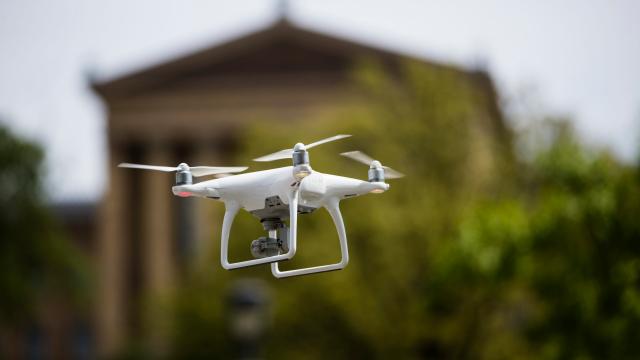Drones are buzzing around the sky delivering products to customers, snapping videos and photos and conducting search and rescue missions, making it necessary for all of these high-flying machines to be regulated – with their own air traffic system set to launch in the US by 2025.
The National Aeronautics and Space Administration (NASA) has been working with the Federal Aviation Administration (FAA) and corporations to research requirements necessary for a drone traffic management system, and whatever they learn will be tested this summer, according to the Los Angeles Times.
FYI: These regulations are focused on commercial drones that fly at heights or in areas where commercial planes are operating. If you’re a regular person who wants to fly your drone in the park, you already don’t have FAA permission to fly your drone out of your sight. The number one concern at the moment is that the drones of major companies like Amazon, which could potentially use them to mail shit hundreds of miles away, could get in the way of oncoming aircraft.
But it will be different from the current air traffic system that has human beings in towers directing aircraft. An electronic system will be used by drone operators that will provide them with constraint notifications and flight information, and what makes the drone air traffic system unique is that drone companies already researching drone navigation will be tasked with handing the heavy lifting of creating the system, not the FAA.
It’s similar to the system in the works for self-driving cars. The Department of Transportation gave the self-driving car industry some loose safety guidelines that the companies are tasked with regulating.
It’s an ideal time to start thinking of drone safety in the air, as there will be more than 7,000 drones in the sky at any given time by the year 2020. Unregulated drone traffic guidelines with that many drones in the air can potentially lead to accidents. There have already been close encounters between drones and commercial aircraft in the past.
Earlier this year, for example, a drone crashed into the Space Needle in Seattle.
Ouch.
Back in 2014, the FAA released a report documenting 25 instances in which a drone came within feet or seconds of hitting a commercial aircraft. Most of the close calls came during takeoffs and landings; Washington and New York were the locations that saw the most incidents. The Washington Post reported at the time of the report that pilots were reporting 25 incidents per month in which drones were flying in restricted air space.
One way NASA research is dealing with this is by facilitating what is called uncontrolled airspace, basically space that isn’t regulated by air traffic management. Requiring drones to operate in this specific air space can prevent them from potentially crashing into commercial aircraft. That said, NASA is planning to eventually integrate drones into air space with manned-aircraft.
The toughest part of all of this — at least between drone operators — is to create a common language that they can all understand without traditional air traffic control’s dedicated human support serving as its eyes and ears. With up to 7,000 drones (or maybe even more) expected to be sharing air space with each other in a few years, manufacturers each may have to share data and share some protocols. Sharing data, however, gets tricky. Drone makers may struggle to create a system that doesn’t require them to share proprietary info to their competitors, as the Los Angeles Times explains:
For all this to work, drones will have to “talk” to each other and exchange information.
NASA, the FAA and the industry will have to figure out the exact types of information that need to pass from one type of drone operating system to another. The systems will also need a common communication protocol and consistent cybersecurity practices.
This can get tricky since drone manufacturers and software developers — like makers of self-driving cars and their software — could resist passing potentially proprietary data to rivals. But NASA’s Kopardekar said that industry partners have so far been willing to collaborate and that no company-sensitive data will be shared.
Then, of course, you have to deal with mapping. Current regulations stipulate that a drone cannot travel out of their operator’s sight without permission from the FAA. Mapping that drone operators share will significantly help them navigate skies miles outside of their eyesight. That kind of mapping, though, will require serious sophistication to determine weather conditions, airports, buildings and other objects or areas that pose safety dangers for the drone and whatever it encounters en route to its destination.
The payoff would be a system that would be pretty much autonomous:
“There won’t be an operator looking through cameras or looking at anything to know the world around the drone,” said Greg McNeal, co-founder of Santa Monica company AirMap. “The drone’s going to have to know it itself.”
All of these developments present a range of challenges, from figuring out how willing drone operators will be when it comes to sharing their own data (even in the name of safety) to how to handle drones that malfunction in flight.
It’s a lot to consider, but at least the feds and private drone manufacturers are thinking about ways to make drones safer before a tragedy occurs.
[referenced url=”https://gizmodo.com.au/2016/12/australian-drone-laws-what-you-need-to-know-before-taking-to-the-skies/” thumb=”https://gizmodo.com.au/wp-content/uploads/2016/08/drones-kill-drones-410×231.jpg” title=”Australian Drone Laws: What You Need To Know Before Taking To The Skies” excerpt=”Whether a beginner, a serious aviation enthusiast, or just a fan of gadgets, many of you will have received drones as Christmas gifts. Unmanned aerial vehicles (UAVs) have surged in popularity and affordability in recent years, and there’s no doubt that recreational drone use is on the rise as a result.”]
